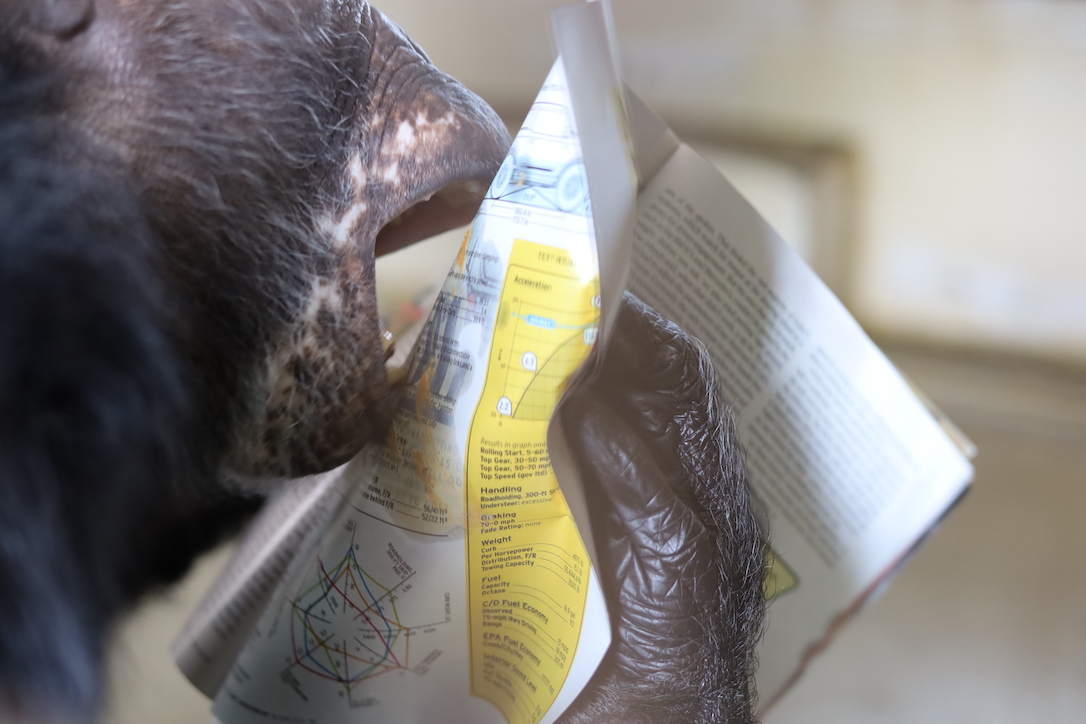Yesterday, Jamie underwent surgery to repair an anal fistula. As I write this, she is bright, alert, and recovering well.
This is a problem we’ve been aware of and have been treating for some time. If you’re not familiar with fistulas, they are small tunnels that connect an infected gland within the anus to an opening on the skin outside the anus. They can be painful and may result in recurring infections and chronic discharge from the opening.
When Jamie’s fistula first appeared, Dr. Erin consulted with other veterinarians and several colorectal surgeons on a course of action. While we were prepared to perform the surgery at that time, and even got as far as purchasing plane tickets for a surgeon from Missouri that had worked on a chimpanzee before, in the end the consensus was that if Jamie was cooperative we could manage her symptoms without surgery. Most humans with the means to do so would probably choose fistula repair, but chimpanzees are somewhat different in that they don’t experience any stigma from fistula symptoms. If we could keep the infection at bay and provide pain relief, we could avoid the trauma of surgery and recovery as well as any potential complications. Jamie was incredibly cooperative – she would allow us (usually Diana, who was her positive reinforcement trainer) to irrigate the tracts with antiseptic solution using a plastic-tipped syringe.
While this had the desired effect at first, over time the infections became more frequent. After additional consultation with colleagues who were planning a similar surgery at an Australian zoo, Dr. Erin decided that it would be in Jamie’s best interest to have her fistulas repaired. Dr. Petty, a colorectal surgeon from Kittitas Valley Hospital in Ellensburg, volunteered to perform the procedure.
Jamie willingly accepts injections – everything from vaccines to anesthetics – so she was ready to go even before we were yesterday morning. She was wheeled into the clinic and masked prior to intubation.
The rest of the team prepared to give Jamie a complete exam while Dr. Petty performed the procedure.
Dr. Petty was pleased to find that most of the tracts were near the surface, which would mean a quicker surgery and faster healing. Fistulotomies, wherein the tracts are opened surgically to heal from the inside out, are often simple enough to be outpatient procedures for humans, but chimps don’t always follow the same level of post-operative care so we will be paying extra close attention to how she heals.
Sofia and Dr. Erin performed a head-to-toe exam while Anthony oversaw the procedure checklist and took photos and video.
Jamie was given an abdominal ultrasound using our Butterfly ultrasound machine. Though the chimps’ usual cardiologist couldn’t make it, she was also given an echocardiogram thanks to a donation of time and equipment from some very generous zoo colleagues.
After getting x-rays and other routine diagnostics, Jamie was wheeled back to the recovery room.
There she would be under close supervision until she was stable and alert.
Everything that we’ve learned from Jamie’s exam so far shows that she’s in good health and we’re hoping that she will not need to spend much time in isolation. For now, we’re trying to keep her enriched with peanut butter magazines and her favorite movies.
Her friends also visit and groom with her at the caging.
Jamie is not one to enjoy sitting around for long, so let’s all wish her a speedy recovery so she can get back to managing her group soon. Many thanks to Dr. Petty and the many other doctors and zoo and sanctuary professionals who helped plan for and carry out this procedure, which we hope will keep Jamie healthy and comfortable.





















